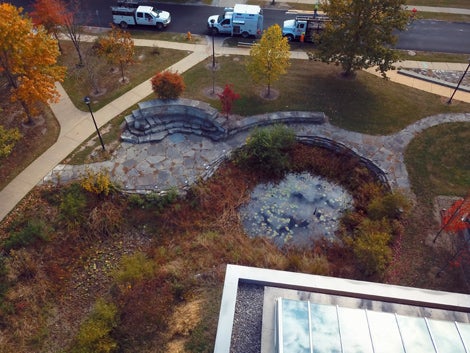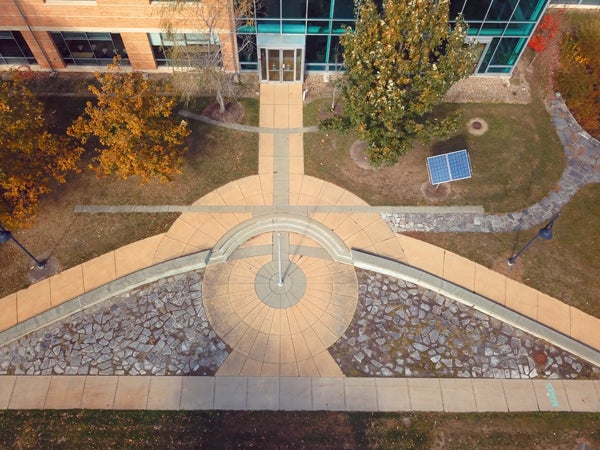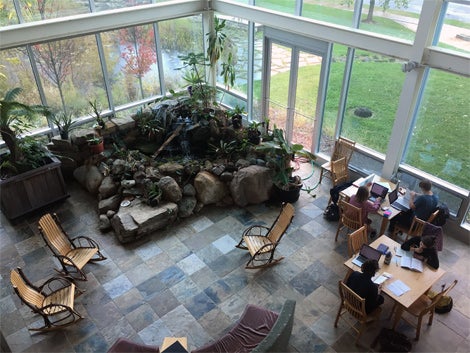Social Landscape
The AJLC building interior and exterior landscape are intended to encourage interaction among people and between people and the environment. The goal is to stimulate reflection on place, on time, and on the ways in which the natural flows of solar energy, the cycling of water, and other materials and the biological diversity support for human culture. As the seasons pass, as people study, work in and visit the center, they develop relationships with each other and with their surroundings. The landscape is a dynamic and interactive influence on the lives and ideas of the people who experience and inhabit it.
Wetland Amphitheatre
 The center was conceived as a building-landscape system that would continue to evolve over time together with the changing desires, needs and opportunities that exist within Oberlin’s Environmental Studies Program and the larger community. In the mid 1990s, through classes and design charrettes, students, faculty, and landscape designers began to explore how a small amphitheatre might enhance interactions between social and ecological landscapes. Completed in 2010, and located on the South East corner of the site, the amphitheatre provides an intimate gathering, teaching and performing space that provides an exceptional view of the restored wetland system, the Living Machine and the reflective east wall of the atrium.
The center was conceived as a building-landscape system that would continue to evolve over time together with the changing desires, needs and opportunities that exist within Oberlin’s Environmental Studies Program and the larger community. In the mid 1990s, through classes and design charrettes, students, faculty, and landscape designers began to explore how a small amphitheatre might enhance interactions between social and ecological landscapes. Completed in 2010, and located on the South East corner of the site, the amphitheatre provides an intimate gathering, teaching and performing space that provides an exceptional view of the restored wetland system, the Living Machine and the reflective east wall of the atrium.
Lyle Sun Plaza
The Lyle Sun Plaza is named for the late John Lyle, a landscape architect who was one of the principal members of the AJLC design team. The plaza, located on the center’s south side, features a gnomon and colored cement arcs that comprise a seasonal sundial. As the sun’s position changes throughout the year, the gnomon shadow follows particular arcs that mark the solstices and equinoxes.

Hydrological Sculpture in the Atrium Lobby
The most prominent feature of the atrium of the center is a 100 square-foot water sculpture collaboratively designed and then installed by local artist Thomas Shurr in 2006. A small pool at the top of the water feature is filled with water by a solar-powered pump. The volume and quality of the sound created by water that falls from this pool into the larger basin is therefore modulated by the solar energy falling within the center landscape. In full sun, the entire atrium space is filled with the sound of a small waterfall. At dawn and dusk or when clouds pass the sound shifts towards the more intimate experience of being within the woods adjacent to a small brook. The natural soundscape and seating area provided by the sculpture has transformed the atrium into a far more intimate space enjoyed by students, faculty and visitors for studying, small-group meetings and meals.
The sculpture was designed to take advantage of salvaged local materials while also featuring global plant diversity. The large sandstone blocks that form the exterior of the sculpture were salvaged during the demolition of the oldest standing house in Oberlin. The chisel marks on each stone are a reminder that the European settlers who extracted this material in the early 1800s used hand tools to extract, cut and shape this abundant local resource. The blocks that form the back of the sculpture are hand-laid with no mortar in the fashion of a local barn foundation. The interior has been designed to simulate a stream ecosystem. A variety of tropical and native plants have been incorporated into the sculpture to create a self-sustaining ecological system that provides a pleasant green environment throughout the year. A number of epiphytical plants from Professor David Benzing’s collection were incorporated into the plant community.
In addition to its social functions, the sculpture serves as a working model of the relationships between energy flow and water cycling that take place in the hydrological cycle that is so crucial to the evolution of life on earth. In nature, solar energy drives the evaporation of water from land and sea. Precipitation that occurs at high points in the landscape collects in rivers and ultimately flows downward to the ocean. In the center’s solar sculpture, solar energy falling on a photovoltaic panel immediately south of the atrium is converted into electricity that directly drives a pump that lifts water to the higher pool from which it falls to the lower pool.
 The sophisticated data monitoring and display system featured in the atrium lobby and on this website provide a critical tool for making the invisible flows of energy and cycles of matter taking place in the center visible to and easily understood by a non-technical audience. At the same time, the hydrological sculpture creates a more tactile and experiential venue for directly engaged in and emotionally connecting with the ways in which solar energy directly drives ecological processes.
The sophisticated data monitoring and display system featured in the atrium lobby and on this website provide a critical tool for making the invisible flows of energy and cycles of matter taking place in the center visible to and easily understood by a non-technical audience. At the same time, the hydrological sculpture creates a more tactile and experiential venue for directly engaged in and emotionally connecting with the ways in which solar energy directly drives ecological processes.
The solar array that drives the water sculpture uses a passive tracking system: Over the course of a day, differential heating of liquid on either side of the array causes the rack to track the sun. This is similar in general concept to the way some plants track the movement of the sun.